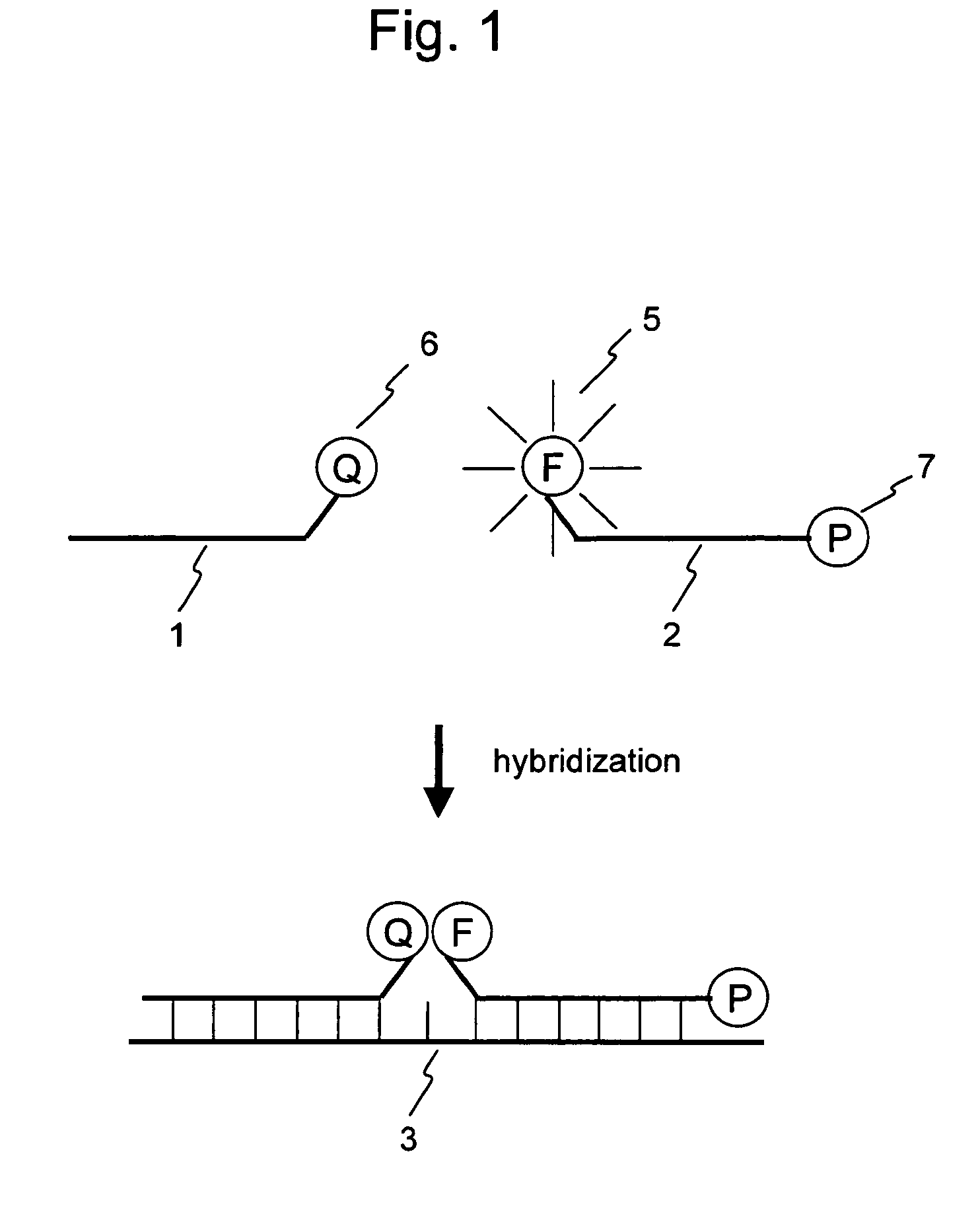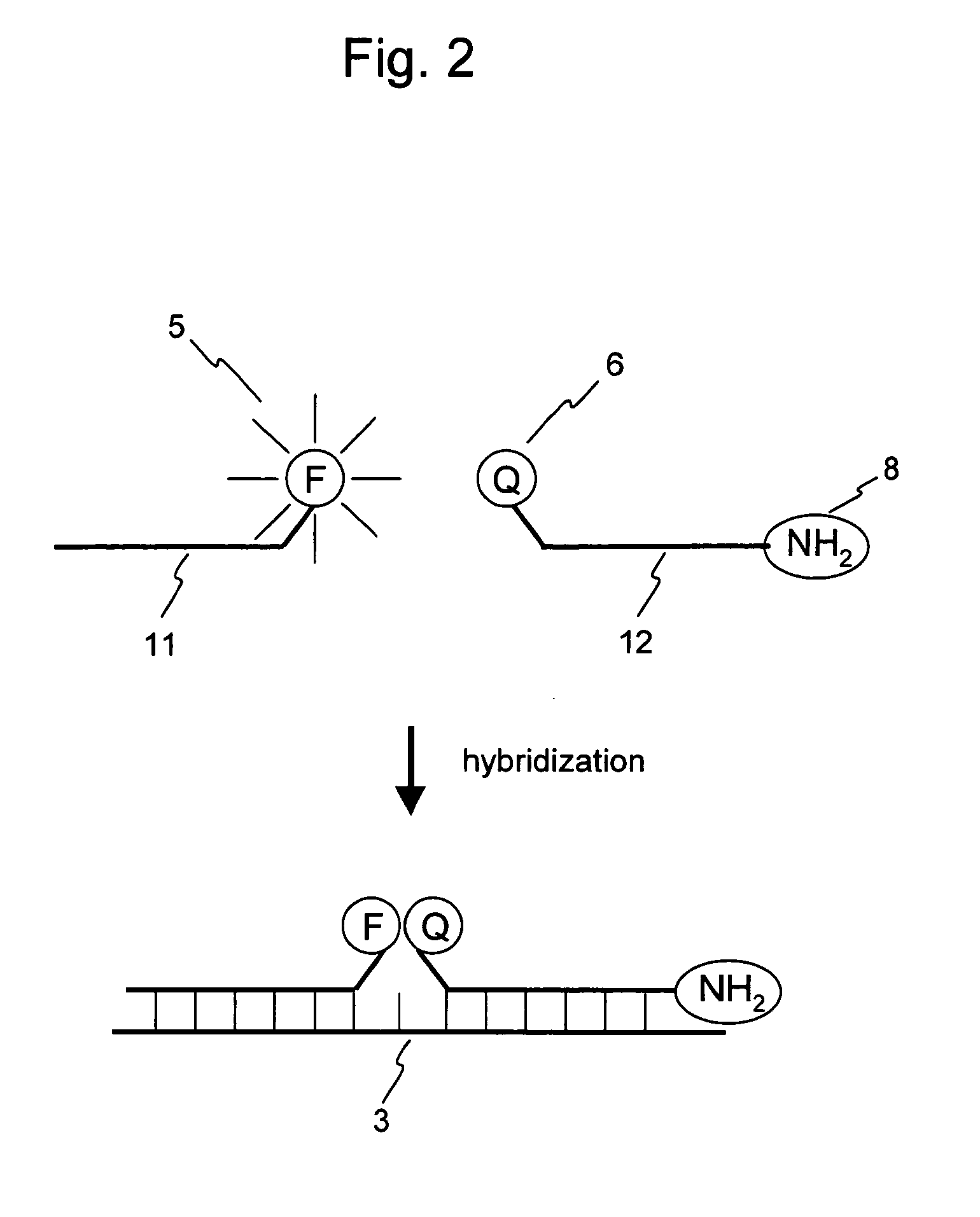Nucleic acid detection probe
a detection probe and nucleic acid technology, applied in the field of nucleic acid (dna or rna) detection methods, can solve the problems of inability to use, increase in background, disadvantageous design of probe sequences with limited degree of flexibility, etc., and achieve the effect of high degree of flexibility
- Summary
- Abstract
- Description
- Claims
- Application Information
AI Technical Summary
Benefits of technology
Problems solved by technology
Method used
Image
Examples
example 1
1. Materials
1) Primers Used in Example 1
[0062]
For LAMP reaction, forward inner primer:(SEQ ID NO: 1)5′-tcc agg ggt ctt aac ttg atg gaa aaa t-3′For LAMP reaction, forward outer primer:(SEQ ID NO: 2)5′-tcc aga aac gtt tcg-3′For LAMP reaction, reverse inner primer:(SEQ ID NO: 3)5′-gga tcc agg ccc aga aaa aaa gac tgt-3′For LAMP reaction, reverse outer primer:(SEQ ID NO: 4)5′-agg gct tgg tca ata t-3′
2) Oligonucleotide Probes Used in Example 1
[0063]
First detection probe:5′-ggt ttc tca gga agc aaa aaa ctt ggc ctt cct gg-(BHQ-1)-3′(SEQ ID NO: 5)Second detection probe:5′-(FAM)-tcc agg ggg tgc tta caa tcc tga tgt ttt cat tc-(P)-3′(SEQ ID NO: 6)
3) Composition of Reaction Solution Used in Example 1 (Values in Parentheses Represent Final Concentrations)
[0064]Tris-HCl pH 8.2 (10 mM), KCl (20 mM), (NH4)2SO4 (5 mM), MgSO4 (2 mM), dATP (0.25 mM), dCTP (0.25 mM), dGTP (0.25 mM), dTTP (0.25 mM), Triton X-100 (0.05%), Betaine (250 mM)
4) Composition of Enzyme Used in Example 1
[0065]Bst DNA polymerase 8 ...
example 2
1. Materials
1) Primers Used in Example 2
[0070]
For PCR reaction, forward primer:(SEQ ID NO: 7)5′-gtc cca tta ttt tcc aga aac gtt tcg-3′For PCR reaction, reverse primer:(SEQ ID NO: 8)5′-aag tac ttc agg gct tgg tca ata t-3′
2) Oligonucleotide Probes Used in Example 2
[0071]
First detection probe:5′-ggt ttc tca gga agc aaa aaa ctt ggc ctt acc tgg-(FAM)-3′(SEQ ID NO: 9)Second detection probe:5′-(BHQ-1)-tcc agg ggg tgc tta caa tcc tga tgt ttt cat tc-(NH2)-3′(SEQ ID NO: 10)
3) Composition of Reaction Solution Used in Example 2 (Values in Parentheses Represent Final Concentrations)
[0072]Tricine-KOH pH 8.0 (40 mM), KCl (16 mM), MgSO4 (3.5 mM), dATP (0.4 mM), dCTP (0.4 mM), dGTP (0.4 mM), dTTP (0.4 mM), BSA (3.75 mg / mL)
4) Composition of Enzyme Used in Example 2
[0073]TITANIUM Taq polymerase 2 U (Clontech)
2. Method
[0074]To confirm whether a target nucleic acid can be detected using nucleic acid detection probes of the present invention described in FIG. 2, PCR reaction was performed, and the amplif...
example 3
1. Materials
1) Primers Used in Example 3
[0078]
For PCR reaction, forward primer:(SEQ ID NO: 11)5′-gca gaa agc gtc tag cca tgg cg-3′For PCR reaction, reverse primer:(SEQ ID NO: 12)5′-cat ggt gca cgg tct acg aga cc-3′Reverse transcription primer:(SEQ ID NO: 13)5′-tgc tca tgg tgc acg gtc ta-3′
2) Oligonucleotide Probe Used in Example 3
[0079]
(SEQ ID NO: 14)5′-(FAM)-tgtt ggg tcgcg aaag gcc ccttc tca ctg ttc tct cat aga agt gat gag gga aca gag cactca tct ctt ctc cct gtt aga ctg cta gcc gag tag-(BHQ-1)-3′
[0080]The underlined parts hybridize to a template.
3) Composition of Reaction Solution Used in Example 3
[0081]In Example 3, Gene Taq Universal Buffer (Nippon Gene Co., Ltd.) was used as a reaction solution. The reaction solution prepared contained dATP (0.2 mM), dCTP (0.2 mM), dGTP (0.2 mM), and dTTP (0.2 mM).
4) Composition of Enzyme Used in Example 3
[0082]Recombinant Taq DNA Polymerase: Gene Taq 0.625 U (Nippon Gene Co., Ltd.)
2. Method
[0083]To confirm whether a target nucleic acid can be de...
PUM
| Property | Measurement | Unit |
|---|---|---|
| Tm | aaaaa | aaaaa |
| temperatures | aaaaa | aaaaa |
| Tm | aaaaa | aaaaa |
Abstract
Description
Claims
Application Information
 Login to View More
Login to View More - R&D
- Intellectual Property
- Life Sciences
- Materials
- Tech Scout
- Unparalleled Data Quality
- Higher Quality Content
- 60% Fewer Hallucinations
Browse by: Latest US Patents, China's latest patents, Technical Efficacy Thesaurus, Application Domain, Technology Topic, Popular Technical Reports.
© 2025 PatSnap. All rights reserved.Legal|Privacy policy|Modern Slavery Act Transparency Statement|Sitemap|About US| Contact US: help@patsnap.com



